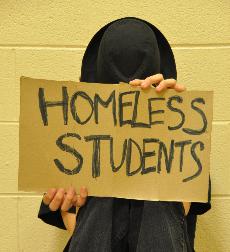The McKinney-Vento Homeless Assistance Act

Overview of the McKinney-Vento Act
Overall, 1,168,354 students enrolled in American preschools and K-12 schools in 2011-2012 were homeless (U.S. News & World Report, 2013). These children and youth face educational challenges that include a lack of basic necessities, such as food, clothing, and medical services.
Since the passage of the original McKinney Act in 1987, the act has been amended many times, the most recent in 2001, as part of No Child Left Behind Act. The McKinney-Vento Act was implemented as the first step to address homelessness by the federal government. It was enacted to ensure educational rights for children and youth experiencing homelessness to ensure full and equal access to public education. Because changing schools has a significant effect on academic and social growth, highly mobile students, including homeless students, have been found to have lower overall academic performance. Therefore, Local Educational Agencies (LEAs) and school districts work to keep homeless students in their original school, provide transportation to their school of origin, if they choose, and to develop policies to remove barriers for enrollment and retention of homeless students.
In order to provide services and drive policy, Federal Law requires each school district to appoint a liaison for homeless students. Liaisons are vital for linking students who are homeless to services and providing stability for them. Because homeless students under the McKinney-Vento Act automatically receive Title I funds, the liaison must allocate funding to provide services that are comparable to Title I services.
The Department of Education awards McKinney-Vento funds to States by formula. The amount that a State receives in a given year is based on the proportion of funds allocated nationally that it receives under Title I, Part A, for that year. Federal funds are distributed to states and school districts through a competitive application process.
McKinney-Vento Act Overview
This video describes the McKinney-Vento act and the responsibilities of local school districts to identify and serve homeless students. It will provide an accurate definition and examples of homeless families in our communities.
Overall, 1,168,354 students enrolled in American preschools and K-12 schools in 2011-2012 were homeless (U.S. News & World Report, 2013). These children and youth face educational challenges that include a lack of basic necessities, such as food, clothing, and medical services.
Since the passage of the original McKinney Act in 1987, the act has been amended many times, the most recent in 2001, as part of No Child Left Behind Act. The McKinney-Vento Act was implemented as the first step to address homelessness by the federal government. It was enacted to ensure educational rights for children and youth experiencing homelessness to ensure full and equal access to public education. Because changing schools has a significant effect on academic and social growth, highly mobile students, including homeless students, have been found to have lower overall academic performance. Therefore, Local Educational Agencies (LEAs) and school districts work to keep homeless students in their original school, provide transportation to their school of origin, if they choose, and to develop policies to remove barriers for enrollment and retention of homeless students.
In order to provide services and drive policy, Federal Law requires each school district to appoint a liaison for homeless students. Liaisons are vital for linking students who are homeless to services and providing stability for them. Because homeless students under the McKinney-Vento Act automatically receive Title I funds, the liaison must allocate funding to provide services that are comparable to Title I services.
The Department of Education awards McKinney-Vento funds to States by formula. The amount that a State receives in a given year is based on the proportion of funds allocated nationally that it receives under Title I, Part A, for that year. Federal funds are distributed to states and school districts through a competitive application process.
McKinney-Vento Act Overview
This video describes the McKinney-Vento act and the responsibilities of local school districts to identify and serve homeless students. It will provide an accurate definition and examples of homeless families in our communities.
Anoka-Hennepin McKinney-Vento Act
The Anoka-Hennepin School District is in Coon Rapids, Minnesota. This video does a great job highlighting the process that a school undergoes when identifying and providing services for homeless students. The video was created in response to a federal grant that the district received.
The Anoka-Hennepin School District is in Coon Rapids, Minnesota. This video does a great job highlighting the process that a school undergoes when identifying and providing services for homeless students. The video was created in response to a federal grant that the district received.
